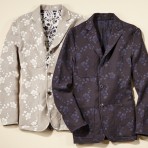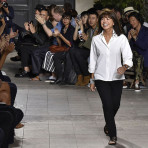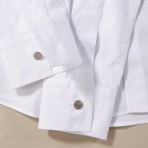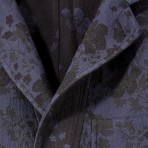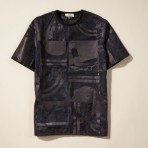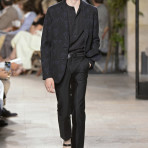A few hours before designer Véronique Nichanian presented her Hermès men’s runway show in June, she took in the setting, a lush, verdant courtyard in Paris’s Cloître des Cordeliers that she said is a well-kept secret.
“Nobody knows that this beautiful garden is back here,” she said.
Something similar could be said of the luxury house’s menswear. Virtually everyone has heard of an Hermès tie. Beyoncé referenced Hermès’s briefcases in her hit “Upgrade U.” But Hermès’s menswear line—including made-to-measure suits, leather jackets and ready-to-wear sweaters, shirts, trousers and jackets—has long been little-publicized. Hermès relies on its aura of quiet luxury—and subtle touches that distinguish its clothes—to help it cultivate a rarefied group of customers.
The label is widely regarded as the most exclusive of the major luxury fashion houses and can command some of the highest prices in the business. It isn’t just its women’s products like its coveted Birkin bags, which start at about $9,400. In menswear, a wool suit can set a man back $5,150. A bomber-style jacket in flannel and wool costs $3,350. A simple-looking wool V-neck sweater with a print goes for a little over $1,600. The label sells $9,100 men’s leather briefcases.
This discreet $4.1 billion company is about to get a little louder about its men’s business. Hermès plans to host an event for 350 guests, including affluent customers but also influential people from the design, architecture and business world, in Chicago Thursday. The event, at the Museum of Contemporary Art Warehouse event space, toasts the launch of Le MANifeste d’Hermès, an ambitious, unconventional website for men. Hermès is also dedicating the entire second floor of its Chicago store to menswear for the week.
As the global menswear market continues to enjoy strong sales growth, Hermès hopes its new men’s website will raise awareness about the breadth of “the Hermès men’s universe,” said Robert Chavez, president and chief executive of Hermès of Paris, the company’s U.S. division. It is holding the event in Chicago to reach a broader base of customers.
Unlike most fashion brands, Hermès has a quiet social media presence. The label doesn’t tout news of the latest celebrity wearing its clothes or carrying its bags. It doesn’t tap celebrities for ad campaigns and “brand ambassador” roles.
She lines the inside pocket of a cashmere coat with lambskin, “because when you put your hand in your pocket, only you will feel the lambskin,” she said.
“It’s my way to talk to the man’s ear,” added Ms. Nichanian, one of the few women in high-end fashion designing menswear.
Details like this have helped Hermès men’s develop a devoted following. “It’s become a club,” she said. “I love to have this connection with men, where they say ‘it’s for me,’ because some of the details, it’s only for you. It’s the sense of the unique. I hate to have big logos.”
For the spring 2016 collection she showed in Paris, Ms. Nichanian introduced reversible tailored blazers. Other reversible garments tend to be outerwear or sportier clothing. Ms. Nichanian’s blazers are single-layered, meaning there is no lining. To achieve this, she used a double-face jacquard with a different pattern on each side. The fact that the jackets are reversible is apparent only to the wearer.
“I love the secret detail and the thing that only the person who wears the garment knows,” said Ms. Nichanian, who joined the company as artistic director of men’s ready-to-wear in 1988. It started back then with a “clou de selle” on each wrist of Hermès shirts—a cuff link that resembles a tack used in saddles and winks at the company’s heritage as a saddle maker. “I thought it was a tiny detail, a signature for Hermès, to have this little thing”—a luxurious touch that others might not notice, she said.
Pamela Golbin, chief curator of fashion and textiles at Les Arts Décoratifs in Paris, said Ms. Nichanian’s subtlety and attention to detail have helped her develop men’s trust. “She has really created a cult customer,” she said. “Her vision is not about a season and the silhouette of the season. It’s about details and materials.” Ms. Golbin noted that Ms. Nichanian updates the menswear “quite slowly,” endearing her to men who want clothing that will still look relevant a year or more after purchase.
Ms. Nichanian became artistic director of the Hermès men’s universe, which oversees all the men’s products, in 2009, and she has been instrumental in coming up with the concept of Le MANifeste d’Hermès. It is less an e-commerce store than it is a playful “interactive webzine,” she said.
At the site, lemanifestedhermes.com, visitors can click on quirky titles such as “3 ways to be king of the castle” to watch a sand-castle-building tutorial featuring models in Hermès clothes, including a double-breasted cashmere coat. Or they can play a game of guessing the contents inside four Hermès bags going through an X-ray machine (including Hermès’s Nautilus fountain pen and Eole riding helmet), or watch live-action and animated shorts showing a man break-dancing in his Hermès scarf, or riding a roller coaster or swimming with dolphins in his Hermès tie. Each segment includes a “featured products” section and links to the main Hermès e-commerce store. The site will also direct viewers to Hermès stores.
The hope is that men will have fun with the site and, Ms. Nichanian said, “set their heart on pieces and click these as desired.”
Written by: Ray Smith for WSJ, Photo: F. Martin Ramin and Getty Images
